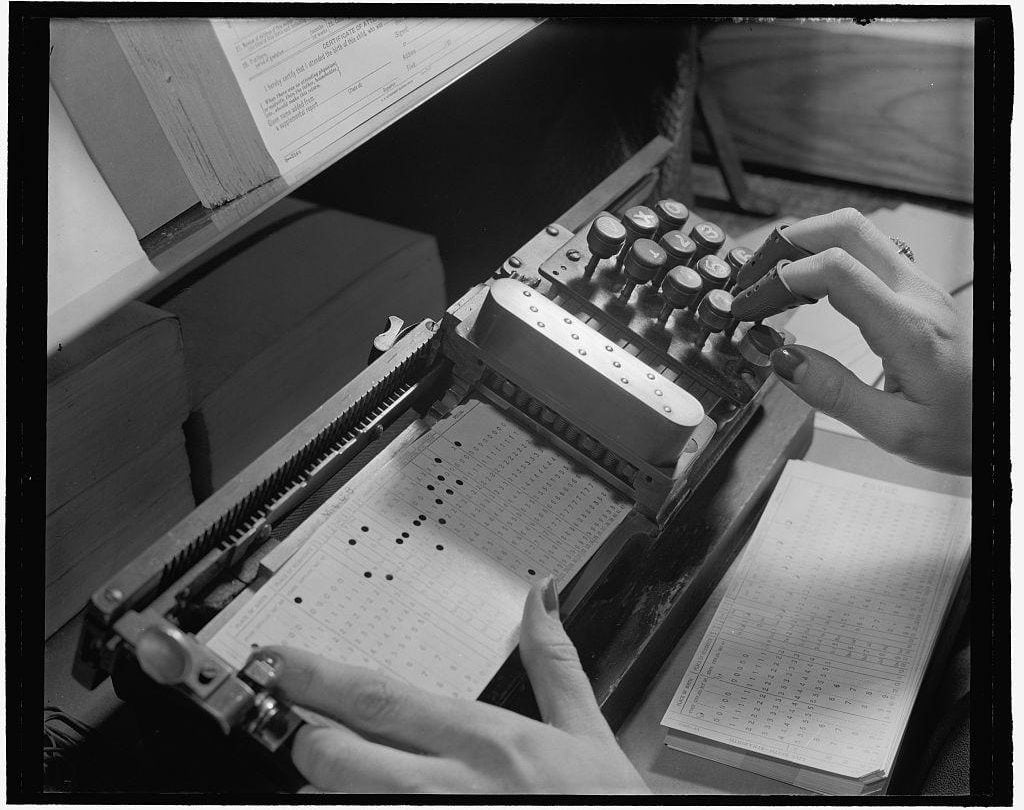
Woman with a tabulation machine at the US Census Bureau c.1940 (Image courtesy of the Library of Congress, LC-DIG-hec-28229.)
The 2020 Census is underway. This year marks the first time in its 230-year history that the Census can be filled out online, making it easier than ever for folks living in the United States to stand up, be counted, and make their voices heard.
Because it only happens once every ten years, it’s easy to forget why the Census is so important to our democracy. From redistricting to nonprofit planning, emergency response preparedness to taxation, apportionment to education—the distribution of resources is determined based on data collected once every decade. To refresh your memory, we’re taking a look at some frequently asked questions surrounding the Census.
What is the Census and why is it important?
The short version? The West Wing’s Sam Seaborn sums it up nicely: “The Constitution mandates that every ten years, we count everybody. . . .Because representation at the various levels of the government—federal, state, and municipal—is based on population. And the only way to find out how many congressmen California gets is to count the people in California.”
The longer version is more complex. Article 1, Section 2 of the United States Constitution mandates that the country count its population once every 10 years. The United States Census counts every living person in the US and five additional territories in order to establish an accurate count.
The Census provides critical data that lawmakers, local business owners, educators, and countless others use to provide support to your community. Data collected by the census helps federal agencies make decisions about where to allocate funding for all sorts of community resources, including schools, hospitals, and roads. Knowing how many people live in the country helps federal lawmakers, as well as state and local governments, better understand where to apportion funding, establish schools, and fund small businesses.
Perhaps more tangibly, the results of the Census also determine the number of seats each state is allotted in the US House of Representatives. Since 1790, Congress regularly increased the number of seats in order to account for population growth. The more people were counted in the Census, the more seats were added. Every state was (and still is) entitled to at least one representative, regardless of population size. When Congress passed the Apportionment Act of 1929, it froze the total number of seats at 435. Today, the number of representatives each state is allotted is determined by how much of the total population lives in each state.
When was the first US Census taken and why?
The first US Census began in August 1790 under the direction of Secretary of State Thomas Jefferson. Our country was freshly on the other side of the American Revolution, and legislators needed a way to count exactly how many people were a part of our brave new nation.
Starting in August 1790, approximately 650 US marshals and assistants recorded answers by hand across 13 states, plus the districts of Kentucky, Maine, and Vermont, as well as the Southwest Territory (now Tennessee). When tallied, the total population of the United States came to 3,929,214. That’s two million fewer people than the population of Metro Atlanta today.
How has the US Census changed over time?
For one thing, the methods of collection have changed. Originally collected in person by US marshals, the Census can now be completed in minutes online. Questions have also come and gone, the length of the questionnaire has changed, and so have procedures for processing data. Perhaps the most striking change over time has to do with who is counted.
The question, “Who counts?” can trace its roots back to the 1787 Constitutional Convention. Delegates (all white, all male, all property owning) fought over who could or would not be counted. Southern delegates found themselves in a logic puzzle—it benefited them to count enslaved individuals because it increased the state’s representation in Congress; however, they also didn’t view the enslaved as people, but property. Northern states pushed back, saying that enslaved people could enjoy no other rights—voting, property ownership, etc.—and therefore shouldn’t be counted. Neither side argued for the abolition of slavery.
To appease the South and assuage the North, an agreement was reached. Known as the Three-Fifths Compromise, it allowed every enslaved American to be counted as three-fifths of a person for the purposes of taxation and representation. Here is the Compromise, written into Article 1, Section 2 the United States Constitution:
“. . . Taxes shall be apportioned among the several States which may be included within this Union, according to their respective Numbers, which shall be determined by adding to the whole Number of free Persons, including those bound to Service for a Term of Years, and excluding Indians not taxed, three fifths of all other Persons.”
The compromise gave the South more power in Washington than it would have had, had the enslaved population not been counted. It also played a direct role in the proliferation of slavery by encouraging southern states to import more enslaved labor and continue to tip the scale.
In 1865, following the end of the Civil War and the passage of the 13th Amendment ending slavery, the Three-Fifths Compromise was rendered moot. When the 14th Amendment was ratified in 1868, the Compromise was officially repealed, and the Constitution’s language amended to reflect the change.
What happens if there’s an inaccurate count?
An undercount of the population would have far-reaching and negative implications on the American people. For one thing, it can significantly alter the way that the US House of Representatives is structured. Congress levies taxes, makes laws, declares war, impeaches and tries federal officers, approves federal appointments, writes the federal budget, and approves treaties. If we do not get an accurate count of each state’s population, then your state may be underrepresented in Congress. As a result, your voice—and the voices of others living in your community—has a smaller impact in Washington.
How can I participate?
We’re glad you asked. Participating is easier than ever this year, with the form being available for completion online. You can also mail in your responses or reply by phone. You can even preview the questions online so you’re prepared before starting your form.
The Census Bureau offers support in 13 different languages over the phone and 59 languages online, guides for responding online, by mail, and by phone, as well as a host of other support options, should you require them. You don’t need to be a US Citizen in order to complete the Census. Everyone living in the United States should be counted! It’s important to note that, by law, your response will be kept completely confidential and your personal information cannot be shared with any law enforcement agencies.
Our country is counting on us to make our voices heard. How will you respond?
Additional. Information.
- 1790 Federal Census Questionnaire | National Archives
- 2020 Redistricting: An Early Look | University of Virginia’s Center for Politics
- Census QuickFacts for Georgia
- Federalist No. 43: The Powers Conferred by the Constitution Further Considered | Congress.gov
- Here’s Why an Accurate Census Count Is So Important | The New York Times
- How the Political Map Is Likely to Shift After the 2020 Census | New York Magazine
- The 2020 Census may be wildly inaccurate—and it matters more than you think | Robert Shapiro, Brookings
- The History of the Three-Fifths Compromise | ThoughtCo.
- Three-Fifths Compromise: Rationalizing the Irrational | National Constitution Center
- U.S. Census Bureau History: History of the Census | US Census Bureau
- Who Counts in 2020? | Code Switch


